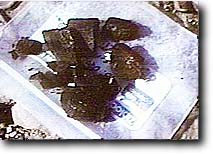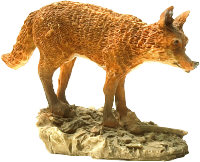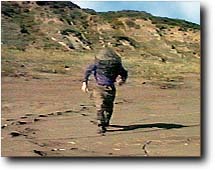

Continuing the dig
We all got up about 8:30. After breakfast, I got a few things organized around my tent. It sure has been nice to camp in one place for a while. Tonight will be the third night we will have been here. Tomorrow we will begin our trip towards Nuiqsut. It is a small Eskimo village about ten miles from the ocean on the Colville river where we will meet our pilot late Friday afternoon.
We still have 35 miles of river to conquer, so we’d like to get an early start in the morning. Just before lunch, I organized all of the dinosaur bones into numbered packages for the trip home. Each person will be responsible for taking one full two gallon zip lock bag with them.
In the morning Buddy and Dan went to the south end of the island to see if they could find any bone material on the bluff. They worked all morning and found just a few small scraps. After lunch, George, Mike and I went over to help them. All of us then hiked over to the Liscomb Bone Bed via the top of the bluff on the tundra to do a little more collecting and to shoot some video of the bone bed. It was about a three mile walk.

On the way we came across a playful red fox. He was very interested in us. Maybe this was the first time he had ever seen a human. He didn’t seem to mind us at all, and followed us along jumping through the tundra much like a family dog would have done.
The view from the top of the bluff of the Colville River Valley was spectacular. Even though we were only 150 feet above the river, we probably could see for ten miles or so to the south and east. To the north and west, all that could be seen was flat, grassy tundra. The tundra looks flatter than it actually is. While walking across it there are many small cracks and gullies several feet wide which act as drainage ditches. Some are fairly deep and are camouflaged by willows and other shrubs growing in them. Most of us stumbled into the hidden cracks at least once.
I don’t think it has rained up here for a while because the high tundra is fairly dry and dusty beneath the shrubs and grasses. The low tundra, closer to the river, is a bit more soggy because of the poor drainage it has. Occasionally the tundra will have a hill or mound on it—maybe twenty-five to one hundred feet in diameter and ten to thirty feet high. Most of these features are “pingos” which result from frost heaving in the tundra soils. As water freezes in the soil, it expands and forces it upward, forming the small hills.

After our nap, we found a gully and hiked down it to the bottom of the bluff. [Dan had a hard time. After watching the video he fell five times walking down the gully. I think he was still pretty exhausted from his quicksand experience.] We collected a few more bone samples and George shot some video of our activities. We walked back to camp along the base of the bluff. As I walked along, I found myself sinking just past my ankles. If I had been any slower or stopped, I may have ended up like Dan did two days earlier. It looked as if this channel had only been dried up for a few days. When the river was higher last week, water was probably flowing through here.
By 9:30 that evening we settled down for the night. Though a small chance, we planned to make it to Nuiqsut by tomorrow. Our bags are quite a bit lighter and roomier because of all the food we have eaten. The empty space and weight will be replaced by all the bones we have collected.



